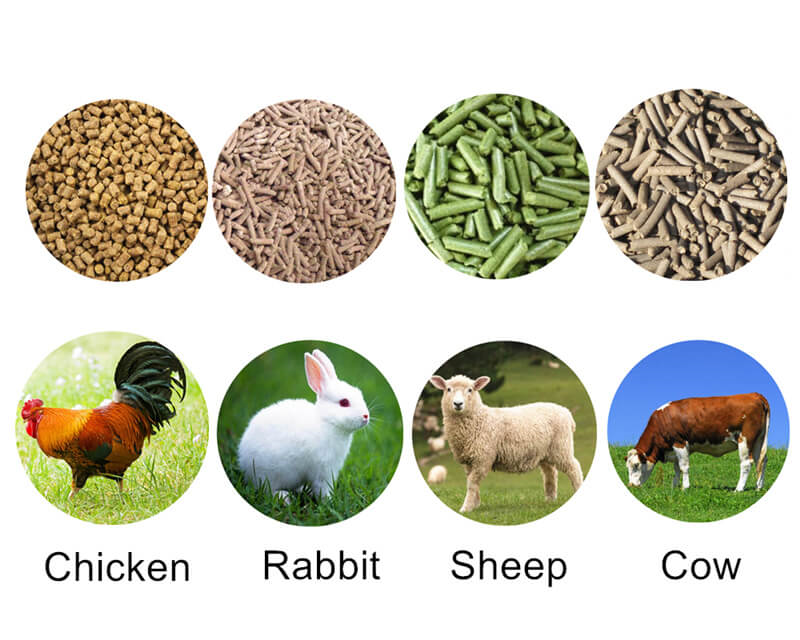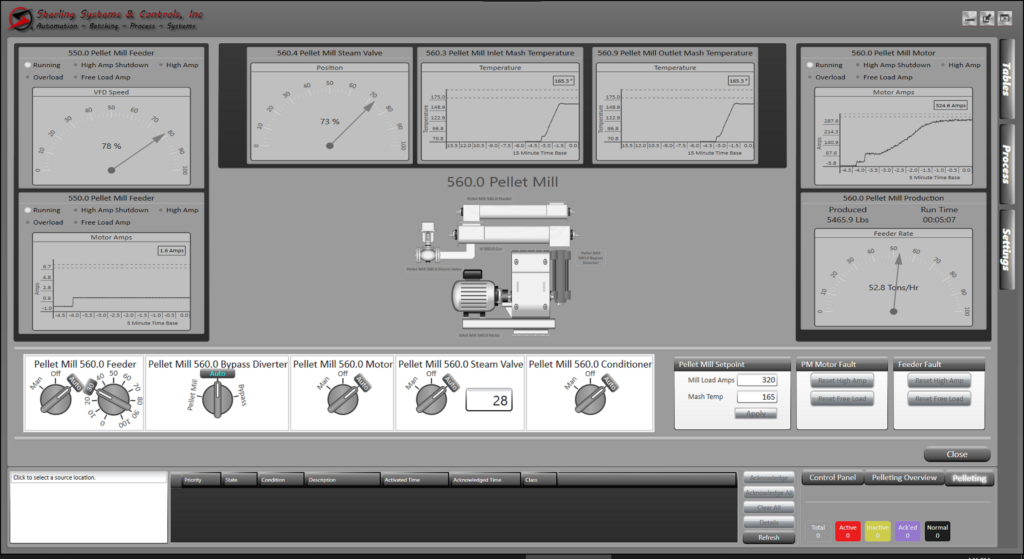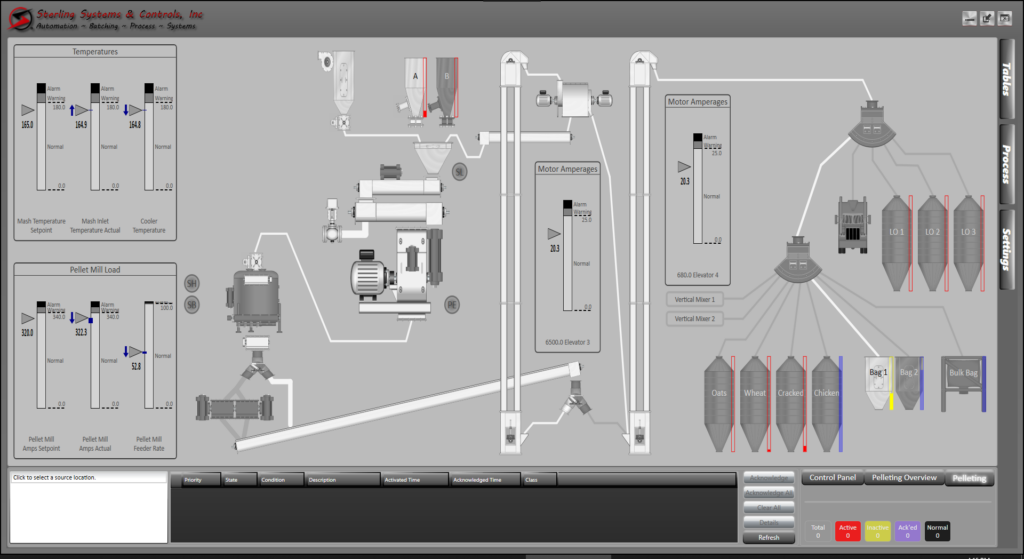Enhancing Animal Health: Controlling the Pelleting Process
Pelleted animal feed play a significant role in animal nutrition. Each animal has a unique gut biome, and today, society increasingly regards animals in a humanistic light, such as viewing our pets as part of the family. The pelleting process enhances the efficiency of animal food production and minimizes production waste. To ensure that the resulting feed is both nutritious and beneficial for the targeted animal’s health, careful monitoring and control of the pelleting process are essential.
This blog explores key factors that influence the quality of the pelleted feed. We’ll look at moisture levels, size of feed pellets, hardness of the resulting pellet from the pellet milling machine, pellet mill monitoring and control, as well as the overall durability of the final pellet.
Why is Overall Pellet Durability Important
Durability is the measure of how well a pelleted feed holds up during its handling and transport. Stronger pellets produce less dust and fines, which help with feed intake and reduces waste. Pick up a handful of feed pellets from its bag, how much comes off in your hand? Do the pellets crumble at all just from handling? A pellet that is durable is less likely to break down. Not only does this ensure that the animal ingesting the food will receive the full nutritional value intended, but it also helps form the purchaser’s impression.
The Pellet Durability Index (PDI) is a common metric used in animal feed manufacturing to assess this pellet characteristic. The PDI measures how well pellets hold together after being subjected to handling, transportation, and processing. To determine the PDI, pellets are subjected to abrasion, and then a measure of how many remain intact without degradation or damage is made. Manufacturers of feed pellets should consider other factors, such as storage conditions and how the pellets are transported and handled, as these factors can also impact durability.
By focusing on improving pellet durability, manufacturers enhance their production and promote better animal nutrition and health.
Finding the Right Balance: Pellet Hardness
What is hardness? Hardness regarding animal feed pellets refers to the resistance of the pellets to deform or break under pressure. This important attribute affects how well the pellets hold their shape during handling, storage, and feeding. Achieving the right level of hardness in pellets is important. If pellets are too soft, they disintegrate too easily, making it challenging for the animals to obtain the required nutrients. On the other hand, if they are too hard, animals may refuse to eat them, hindering their growth and health.
Hardness measurement of a pellet is accomplished by measuring the force needed to penetrate a pellet. Various tools are available. It’s necessary to understand that different animals have preferences when it comes to pellet hardness. This needs to be understood through good research and utilized to ensure the most optimal pellet hardness for the targeted animal is used. For example, young piglets generally prefer softer pellets for easier consumption, while adult rabbits often naturally like a harder pellet as it supports better dental health. The adult rabbits do not consciously understand this, but their natural behavior and instincts guide them in this, and we observe this behavior. Understanding all these preferences is key to formulating effective animal feed.
Size Does Matter
Consistent pellet size is important for ensuring that your targeted animals receive a balanced diet, the right nutrition to support a good gut biome and optimal health. If pellets differ in size too much then the animals may exhibit feed sorting behavior, pick and choose, eating only what they favor and ignoring others. This type of sorting behavior can then lead to nutritional imbalance and have negative impact on their health.
Methods like sieve analysis and image-based particle sizing are often used to check for consistent size. Sieve analysis involves running pellets through a set of screens to assess size distribution, while image-based techniques use digital tools for precise measurements, capturing images, processing them, analyzing size and shape, and then output to compile results. Image-based analysis is beneficial, as it offers accurate and quick evaluation without physically contacting samples of the feed pellet.

Additionally, regular visual checks can give pellet machine operators a quick check, allowing them to adjust for better consistency. When pellet size is consistent it aids nutrient absorption in the animal and increases efficiency in feed production.
Controlling Moisture: Key to Pellet Stability
Moisture content is important for ensuring the long-term stability of pellets. This is especially important for storage and shelf life. Too much moisture can cause mold, and the pelleted feed will spoil posing serious health risks for the animals. Insufficient moisture makes the pellets brittle, increasing the chance of damage and breaking during handling.

To ensure high-quality pelleted feed, it’s important to maintain the proper moisture levels during the pelleting process and in the pellet mill. Ideally, pellets should have a moisture content of between 10% and 12%. A moisture level above 12% creates an environment conducive to mold growth. A moisture level below 10% makes the pellets too brittle. The range stated provides good moisture content and ensures pellet integrity and good nutrient absorption by the animals.
Implementing effective moisture control by using moisture sensors and adjusting drying times can significantly enhance pellet quality and prolong shelf life. Controlling and monitoring temperature and steam valve position (0-100% open) impact pellet moisture content. Continuous moisture monitoring systems or sample testing may be used to ensure proper moisture range and adjust pellet mill temperature and steam valve as needed.
Managing Dust in Pellet Production to Ensure Quality and Safety
Dust is a significant challenge in pellet production, impacting worker safety and pellet quality. Inhaled dust can cause respiratory issues, and high dust levels often indicate problems with pellet integrity and durability.
To effectively manage dust, manufacturers should consider the following:
- Enhance Production Processes: Adjusting pellet mill settings can reduce breakage and minimize dust generation.
- Utilize Dust Control Tactics: Implementing methods like water misting and dust collection systems can lower airborne dust and improve air quality.
- Measure Dust Emissions: Regularly assessing the Dustiness Index through lab tests provides insights into dust levels for timely production adjustments.
- Recycle with Care: Recycling dust back into production can be beneficial, but it must be done cautiously to avoid compromising final product quality.
- Educate Employees: Training in dust exposure risks and providing personal protective equipment (PPE) are essential for a safe work environment.
What is a Pellet Mill
A pellet mill, or pellet press, is a machine that makes pellets from powdered materials. It’s super important in industries like animal feed manufacturing. Please note that extruders are the primary choice for producing pet food kibble due to their cooking capabilities, however, pellet mills are used effectively for manufacturing specific pet food formulations, supplements, or in cost-sensitive or smaller-scale operations.
The pellet mill works by compressing raw materials through a die, which has holes of different sizes. It all starts with feedstock—like a blended batch of grains, forages, and other ingredients—getting fed into the mill. As the materials move through, they’re pressed under high pressure and heat, which makes them stick together and form pellets.

First, a feed auger delivers the raw ingredients (mash) into the pellet chamber, ensuring a steady flow. Often, the material gets some steam or water added to it, making it easier to compress and improve the final pellet quality.
Once the material is ready, it goes into the die chamber, where rollers push it through the holes. This forms long strands of pellets, which are then cut to size by a knife mechanism. After that, the hot pellets are cooled to keep them stable for storage and transport.
There are two main types of pellet mills: flat die and ring die. Flat die mills are great for small-scale production and easier to manage, making them popular for home or small farm use. Ring die mills, on the other hand, are built for larger operations and can produce pellets more efficiently, perfect for big farms or feed mills.
These mills are mainly used to make animal feed pellets, and some pet food products, which pack in a lot of nutrition for animals. They also are used to produce biomass pellets for fuel, an eco-friendlier energy option. You’ll even find them used for aquaculture.
In short, a pellet mill is a key piece of equipment in various industries, especially in animal feed/food production. It helps produce high-quality pellets that meet specific nutritional needs, making it easier for manufacturers to get the job done right.
The Importance of Good Pellet Mill Control and Monitoring
Good monitoring and control of a pellet mill are crucial for ensuring that everything runs smoothly and produces high-quality pellets. Monitoring various factors during the pelleting process can help prevent problems and improve overall efficiency.

First off, monitoring allows you to catch issues before they become major headaches. By keeping track of things like temperature, pressure, and moisture levels, you can ensure that the raw materials are being processed correctly. If something is off, like too much moisture or temperature fluctuations, it can lead to poor pellet quality or even equipment failure.
Another important aspect is consistency. Regular monitoring helps maintain uniformity in pellet size and quality, which is key for animal nutrition. If the pellets vary too much, animals might not get the balanced diet they need, affecting their health and growth.
Control systems also enable you to adjust parameters in real-time. For instance, if you notice the pellets are coming out too soft or too hard, you can tweak the settings to improve the final product. This flexibility is essential for meeting specific requirements based on the type of feed being produced.
Additionally, good monitoring can lead to better resource management. By tracking how much energy and raw materials are used, you can identify ways to reduce waste and save on costs. This is good for your bottom line and benefits the environment by minimizing resource usage.
Overall, investing in robust monitoring and control systems for your pellet mill pays off in better product quality, improved efficiency, and lower costs. It’s all about avoiding potential problems and ensuring you’re delivering the best possible pellets.
The Impact of Quality Pellets on Animal Nutrition
The quality of the pellets plays a huge role in animal health and performance. Strong pellets with the right durability, hardness, size, moisture, and minimal dust ensure that animals get the nutrients they need, improving feed efficiency and reducing health risks.
High-quality pellets not only enhance nutrient absorption but also contribute to better growth rates and overall well-being. Quality feed reflects a commitment to animal welfare, supporting productivity and favorable nutritional outcomes. This is increasingly important to brand loyalty and consumer preferences, as animal advocacy and the humanization of pets continues to grow.
Conclusion
The quality of feed pellets is crucial for ensuring optimal health and performance in animals, livestock and pets. Producers can significantly enhance the nutritional value of their products by focusing on factors such as durability, hardness, size distribution, moisture content, and dust management.
Investing in rigorous quality assessment and management practices not only boost product efficiency but also support animal welfare and overall productivity. As the demand for high-quality animal food/feed continues to rise, prioritizing pellet quality will be vital for sustainable and successful livestock production and pet welfare. By adopting these practices, livestock producers and pet owners can ensure their animals receive the best possible nutrition, leading to healthier livestock and pets, and better outcomes for industries overall.
Next Steps
With over 50 years of expertise in custom engineering solutions for animal feed and pet food manufacturing in dry material weighing and batching, process controls, and bulk material handling systems, Sterling Systems & Controls proudly has the experience to provide you with expert guidance to achieve your pelleting, automation and process improvement goals. Contact us today to discuss how our knowledge and expertise can align with your goals, and how you can continue your journey toward manufacturing excellence!